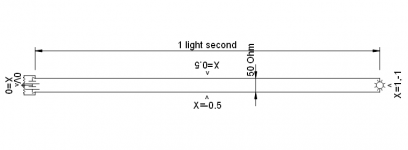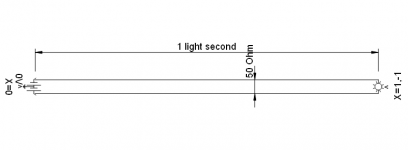winnie
Senior Member
- Location
- Springfield, MA, USA
- Occupation
- Electric motor research
Okay, with a revised image:


-Jon

Yes, though I had to add some resistors to ground, otherwise the transmission line is not connected to our ground reference at all. With the resistors to ground, before the switch is closed V(x) is uniformly 0.A) Suppose at time t < 0, neither side of the battery is connected to the transmission line (i.e. we have a double throw switch). But everything is in the fixed geometry specified. Is the voltage scalar field defined on the transmission line?
AgreedNow at time t=0, we throw the switch. For t >> 1, the steady state will be that V(x) = +0.5V on (0,1), and V(x) = -0.5V on (-1,0). The steady state current will be +5ma everywhere.
Agreed.For t < 0, the current will be 0 everywhere, and the V(0+) = +1/2V, V(0-) = -1/2V, and V(x) for other x depends on the answer to (A).
AgreedB) At time 0 < t < 1, I think we have that V(x) =+0.5V for 0 < x <t, V(x) = -0.5V for -t < x < 0, and the V(x) elsewhere is presumably unchanged from time t < 0, so it depends on the answer to (A).
This is not clear. What is I(t)? The current out of the battery at time t? Or the current at a location?And at time t, I(t) = 20 ma displacement current per the video.
For t<1 I(x) for -t < x <t is 20ma except at the transition. In the approximation of a perfect (0 width transmission line) the transition is a step function matching the switch closure. For a real transmission line I am not sure of the shape. When t>1 we should see a change with current dropping to less than 20mA as the 'reflection' from the unmatched termination (200 Ohm load on a 50 Ohm line) starts going back.But what is I(x) for -t < x < t, is it 20 ma, or 0 ma, or ? For |x| > t, I(x) = 0.
I would say that V(x) would start uniformly 0V, but the transition would be no different. In this approximation we are ignoring any sort of coupling to the surrounding earth/ground.C) Suppose instead of using a double throw switch, we have a single throw switch at x = 0+. How do the answers to A and B change?
It gets easier if you match the load to the transmission line. Then you don't have to figure out the reflections at the batteryD) I'm sure the question of what I(x) and V(x) look like at t greater than but near 1 are of interest, but that's too much for the moment.
-Jon


